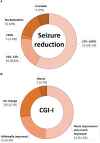Management and outcome of vagus nerve stimulator implantation: experience of an otolaryngeal/neuropediatric cooperation
- PMID: 34196736
- PMCID: PMC8382619
- DOI: 10.1007/s00405-021-06943-x
Management and outcome of vagus nerve stimulator implantation: experience of an otolaryngeal/neuropediatric cooperation
Abstract
Objective: Vagus nerve stimulator (VNS) implantation is an established therapy for pharmacoresistant epilepsy that is not amenable to curative epilepsy surgery. Historically, VNS implantation has been performed by neurosurgeons, but otolaryngologist involvement is increasingly common. In this retrospective study, we aimed to evaluate the efficacy and safety of VNS implantation in children and adolescents from the otolaryngologists' perspective.
Methods: This study included children and adolescents who had undergone VNS implantation at the study center between 2014 and 2018. Patient files were analyzed with regards to the durations of device implantation and hospitalization, postoperative complications, and clinical outcome, including seizure frequency, clinical global impression of improvement (CGI-I) score, and quality of life (QoL).
Results: A total of 73 children underwent VNS surgery. The median age at implantation was 9.3 ± 4.6 years, and median epilepsy duration before VNS surgery was 6 ± 4 years. Lennox-Gastaut syndrome was the most common syndrome diagnosis (62.3%), and structural abnormalities (49.3%) the most frequent etiology. Operation times ranged from 30 to 200 min, and median postoperative hospitalization length was 2 ± 0.9 days. No complications occurred, except for four revisions and two explantations due to local infections (2.7%). Among our patients, 76.7% were responders (≥ 50% reduction in seizure frequency), 72.1% showed improved CGI-I scores, and 18.6-60.5% exhibited considerable improvements in the QoL categories energy, emotional health, and cognitive functions.
Conclusion: Our results indicate that VNS implantation is a highly effective and safe treatment option for children and adolescents with AED-refractory epilepsies who are not candidates for curative epilepsy surgery.
Keywords: Children; Epilepsy; Outcome; Perioperative management; Vagus nerve stimulator (VNS) surgery.
© 2021. The Author(s).
Conflict of interest statement
All authors declare that they have no competing interests.
Figures
References
MeSH terms
LinkOut - more resources
Full Text Sources


